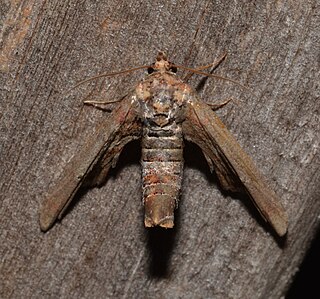
Urodidae, whose species are commonly known as false burnet moths, is a family of moths in the lepidopteran order. It is the type genus in the superfamily, Urodoidea, with three genera, one of which, Wockia, occurs in Europe.

Heliodinidae, commonly known as sun moths, is a family of small moths with slender bodies and narrow wings. Members of this family are found in most parts of the world. Heliodinid moths are brightly coloured day-flying moths. The base of the haustellum is bare. The scales on the head are compact and appear like a shield. Many Heliodinidae raise their hindlegs when resting but this is not a taxonomic feature and several genera like Epicroesa and Lamprolophus do not show this posture. Many Heliodinidae have the inner and outer spurs of the metatibia subequal. The larval host plants of the majority of species are in the Aizoaceae, Chenopodiaceae, Phytolaccaceae, Portulacaceae and Nyctaginaceae, all in the Order Caryophyllales. A few feed on Onagraceae, Araliaceae and Piperaceae. The larvae's feeding strategies include skeletonizing leaves, boring into leaf stems, leaf mining, and opportunistically invading cecidomyiid galls. The pupae have long stiff hairs on their back sides.
Metachanda is the sole genus in tribe Metachandini of moth subfamily Oecophorinae. Metachandini was originally described as family Metachandidae by Edward Meyrick in 1911, and at the time also contained the genus Chanystis, which is currently unplaced to tribe within Oecophorinae. It has also previously been described as tribe Metachandini of subfamily Gelechiinae.

Agathiphaga is a genus of moths, known as kauri moths. and is the only living genus in the family Agathiphagidae. This caddisfly-like lineage of primitive moths was first reported by Lionel Jack Dumbleton in 1952, as a new genus of Micropterigidae.
Calonotos is a genus of moths in the subfamily Arctiinae. The genus was erected by Jacob Hübner in 1819.

Estigmene is a genus of tiger moths in the family Erebidae erected by Jacob Hübner in 1820. The species in the genus are native to North and Central America.
Stenopterosia is a genus of moths in the subfamily Arctiinae. It contains the single species Stenopterosia angustipennis, which is found in Vietnam.
Thyrosticta is a genus of moths in the subfamily Arctiinae. The genus was erected by George Hampson in 1898.
Aethodes is a monotypic moth genus of the family Noctuidae. Its only species, Aethodes angustipennis, is found in Nigeria and Ghana. Both the species and genus were first described by George Hampson in 1918.

Marathyssa is a genus of moths of the family Euteliidae. The genus was erected by Francis Walker in 1865.
Toxocampa is a genus of moths of the family Noctuidae. The genus was erected by Achille Guenée in 1841. Lepidoptera and Some Other Life Forms and The Global Lepidoptera Names Index describe this name as a synonym of Lygephila.

Blepharoctenucha is a monotypic moth genus in the family Geometridae described by Warren in 1895. Its only species, Blepharoctenucha virescens, first described by Arthur Gardiner Butler in 1880, is known from India and Taiwan.
Celonoptera is a monotypic moth genus in the family Geometridae. Its only species, Celonoptera mirificaria, is found in south-eastern Europe. Both the genus and species were first described by Julius Lederer in 1862.

Cimicodes is a genus of moths in the family Geometridae. It has totally 13 species.
Megalotica is a genus of moths in the family Geometridae described by Zimmerman in 1958.
Isospidia is a genus of moths belonging to the subfamily Drepaninae.
Calonotos angustipennis is a moth of the subfamily Arctiinae. It was described by Zerny in 1931. It is found in Brazil and French Guiana.
Paraethria angustipennis is a moth of the subfamily Arctiinae. It was described by Rothschild in 1911. It is found in Brazil (Amazonas).
Thyrosticta angustipennis is a moth in the subfamily Arctiinae. It was described by Ferdinand Le Cerf in 1921. It is found on Madagascar.
Isospidia angustipennis is a moth in the family Drepanidae. It was described by Warren in 1904. It is found in Cameroon, the Central African Republic, Ghana, Ivory Coast, Nigeria and Uganda.






